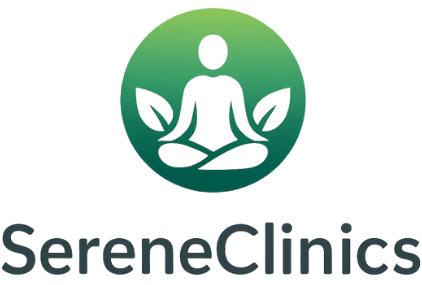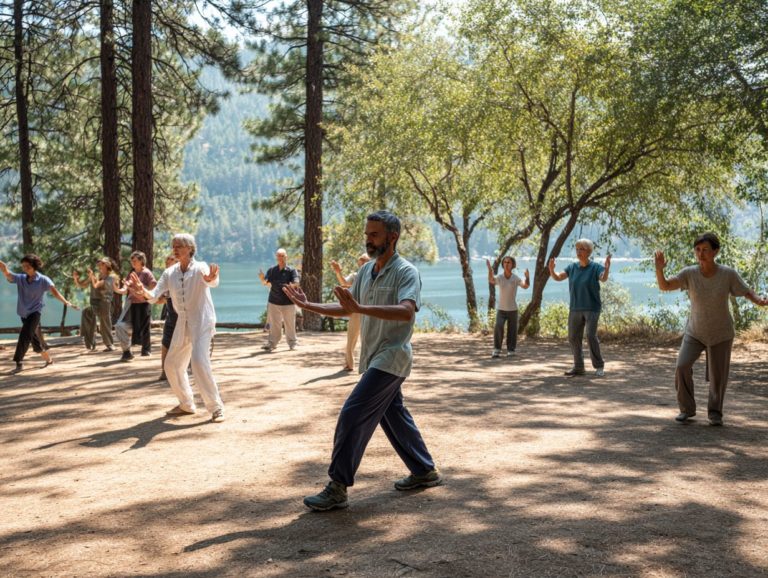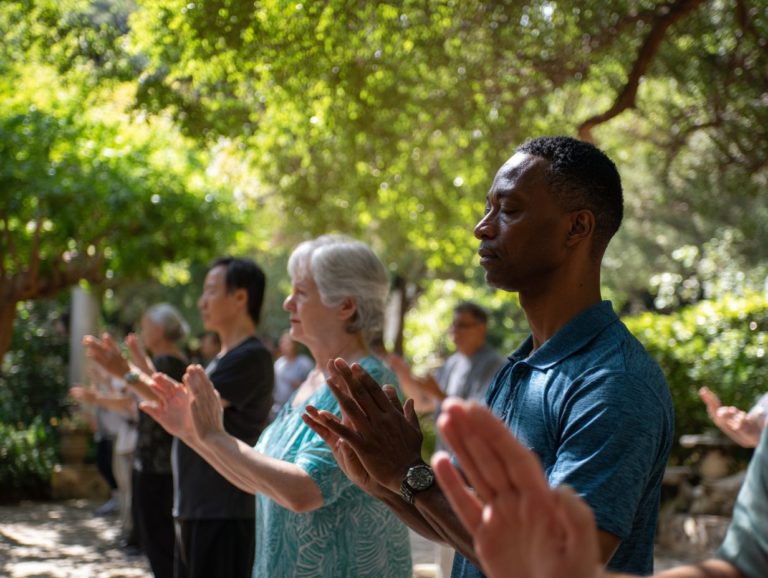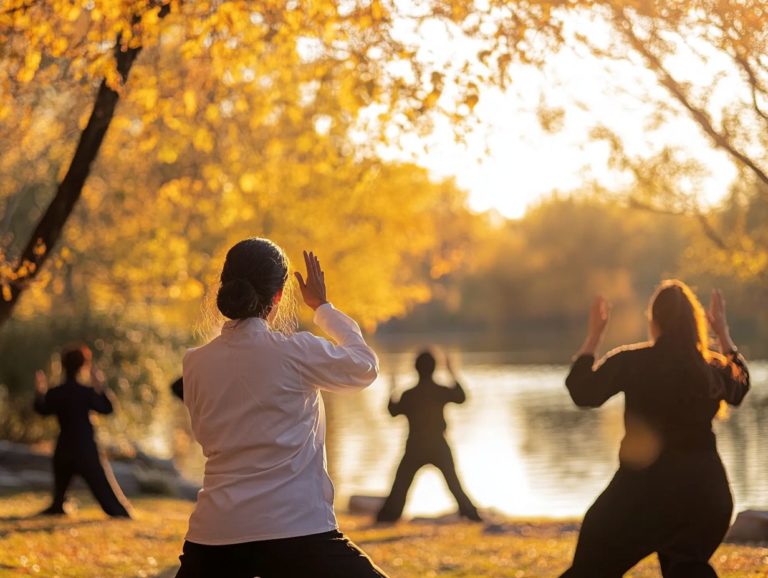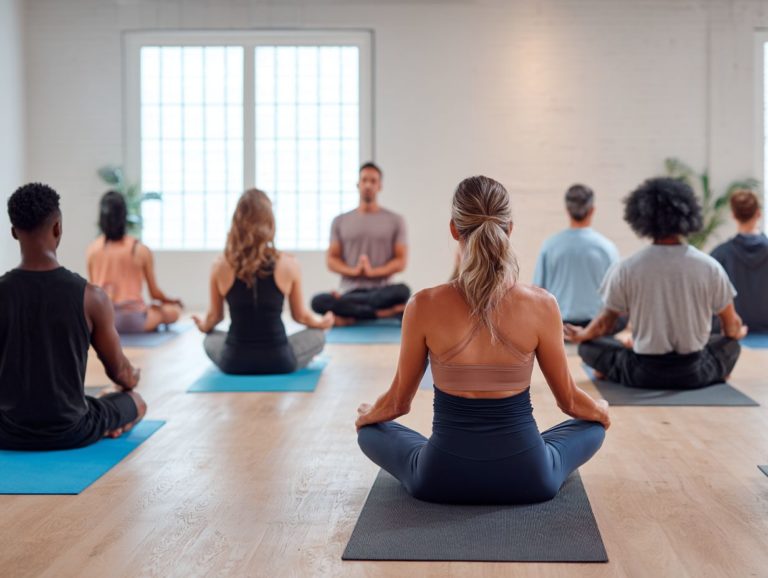Tai Chi: Health Benefits, Techniques, and Wellness Tips
Experience the benefits of tai chi, an old form of exercise that improves physical and mental health with calm, flowing movements and relaxed breathing. Experts such as Tim Sobo and the Cleveland Clinic note that this practice helps with relaxation and improves health. In this article, you’ll learn about tai chi’s significant health benefits, important techniques, and wellness advice to easily include it in your daily life. Embrace tranquility and vitality today!
Key Takeaways:
Contents
- 1 Health Benefits of Tai Chi
- 2 Health Benefits of Tai Chi
- 2.1 Tai Chi Evidence and Benefits: Excellent Evidence Conditions
- 2.2 Tai Chi Evidence and Benefits: General Health and Fitness
- 2.3 Tai Chi Evidence and Benefits: Good Evidence Conditions
- 2.4 Tai Chi Evidence and Benefits: Fair Evidence Conditions
- 2.5 Physical Health Benefits
- 2.6 Mental Health Benefits
- 2.7 Emotional Well-being
- 2.8 Impact on Chronic Conditions
- 3 Tai Chi Techniques
- 4 Wellness Tips for Practicing Tai Chi
- 5 Research and Evidence
- 6 Frequently Asked Questions
- 6.1 What is Tai Chi and what are its health benefits?
- 6.2 What techniques are used in Tai Chi and how do they promote wellness?
- 6.3 Can Tai Chi be beneficial for individuals of all ages and fitness levels?
- 6.4 How often should one practice Tai Chi to see its health benefits?
- 6.5 Are there any precautions one should take when practicing Tai Chi?
- 6.6 Can Tai Chi be combined with other forms of exercise and wellness practices?
Overview of Tai Chi

Tai Chi, often called ‘meditation in motion,’ is a gentle exercise that improves body awareness through specific movements.
This practice focuses on being aware, steady, and flexible, so it’s suitable for older adults and beginners.
By focusing on slow, deliberate movements, practitioners improve muscle strength and joint stability, while enhancing mental clarity. This holistic approach is deeply rooted in the principles of Traditional Chinese Medicine, which emphasizes balance and harmony.
For example, Tai Chi for Arthritis offers simple routines designed for people with limited movement.
Online platforms such as Tai Chi Online offer guided sessions, allowing participants to practice at their own pace.
Practicing Tai Chi regularly can reduce stress and improve your health, making it a beneficial addition to any exercise routine.
Historical Background
Originating from ancient Chinese martial arts, Tai Chi has evolved into a practice emphasizing health and relaxation over combat.
Tai Chi started as a self-defense method and uses slow, careful movements to improve the body’s energy, known as ‘Qi’. Traditional Chinese medicine emphasizes its benefits, as practitioners believe that gentle movements help keep balance and calm, reduce stress, and improve overall health. This aligns with insights from Medical News Today, highlighting that Tai Chi’s gentle movements can significantly contribute to stress reduction and overall wellness.
Over hundreds of years, Tai Chi has changed to fit different cultures, resulting in styles like Yang, Chen, and Wu. Today, it is both a martial art and a form of exercise. People around the world practice it to improve their physical fitness and mental focus.
Health Benefits of Tai Chi
Studies indicate that practicing Tai Chi provides many health advantages, especially for older adults dealing with physical and mental difficulties.
Health Benefits of Tai Chi
According to an article from ScienceDirect, Tai Chi can significantly improve physical health, enhance mental well-being, and reduce symptoms of chronic conditions, making it a highly beneficial practice for older adults. If you’re curious about how Tai Chi fits into broader mind-body practices, explore Yoga and Tai Chi at Serene Clinics for a deeper understanding.
Health Benefits of Tai Chi
Tai Chi Evidence and Benefits: Excellent Evidence Conditions
Tai Chi Evidence and Benefits: General Health and Fitness
Tai Chi Evidence and Benefits: Good Evidence Conditions
Tai Chi Evidence and Benefits: Fair Evidence Conditions
The data on the Health Benefits of Tai Chi illustrates its efficacy in enhancing various health conditions and promoting general fitness. This analysis categorizes the benefits into four sections, based on the strength of the evidence supporting each condition.
Tai Chi Evidence and Benefits shows strong proof of its usefulness in treatment. The category of Excellent Evidence Conditions showcases Tai Chi’s significant impact on areas such as:
- Preventing Falls: With a 100% effectiveness rate, Tai Chi is highly recommended for fall prevention, especially among older adults.
- Osteoarthritis Improvement: At 90%, Tai Chi aids in alleviating the symptoms of osteoarthritis, improving joint pain and function.
- Parkinson’s Disease Mobility & Balance: Tai Chi improves movement and balance with 85% success rate, which is very important for individuals with Parkinson’s disease.
- COPD Rehabilitation Improvement: An 88% effectiveness indicates significant benefits in respiratory rehabilitation for COPD patients.
- Cognitive Capacity Improvement: Tai Chi significantly improves thinking skills, being effective 90% of the time.
The General Health and Fitness section explains how Tai Chi improves physical abilities, such as:
- Balance Improvement: At 95%, Tai Chi is extremely effective in enhancing balance.
- Muscle Strength Improvement: It greatly increases muscle strength with a 90% success rate.
- Flexibility Improvement: Tai Chi improves flexibility by 85%.
- Aerobic Capacity Enhancement: It improves aerobic capacity by 80%.
- Overall Well-being Improvement: Increases overall well-being by 75%.
In Good Evidence Conditions, Tai Chi is shown to be beneficial, albeit to a slightly lesser degree. Conditions like:
- Depression Improvement: 70% effectiveness shows substantial help in mood improvement.
- Cardiac Rehabilitation Effectiveness: Tai Chi helps 75% of people recover from heart problems.
- Stroke Rehabilitation Effectiveness: At 78%, it supports stroke recovery.
- Dementia Improvement: 80% effectiveness in aiding cognitive functions in dementia patients.
The Fair Evidence Conditions category indicates moderate benefits of Tai Chi in supporting:
- Cancer Patient Quality of Life: A 65% improvement in quality of life for cancer patients.
- Fibromyalgia Symptom Relief: 68% effectiveness in mitigating fibromyalgia symptoms.
- Hypertension Control: Tai Chi aids in controlling hypertension with a 70% success rate.
- Osteoporosis Management: 60% effectiveness in managing osteoporosis.
- Sleep Quality Improvement: It provides a 60% improvement in sleep quality.
The data shows that Tai Chi is useful for therapeutic exercise, supporting particular health benefits and better general fitness, making it a useful practice for various health needs.
Physical Health Benefits
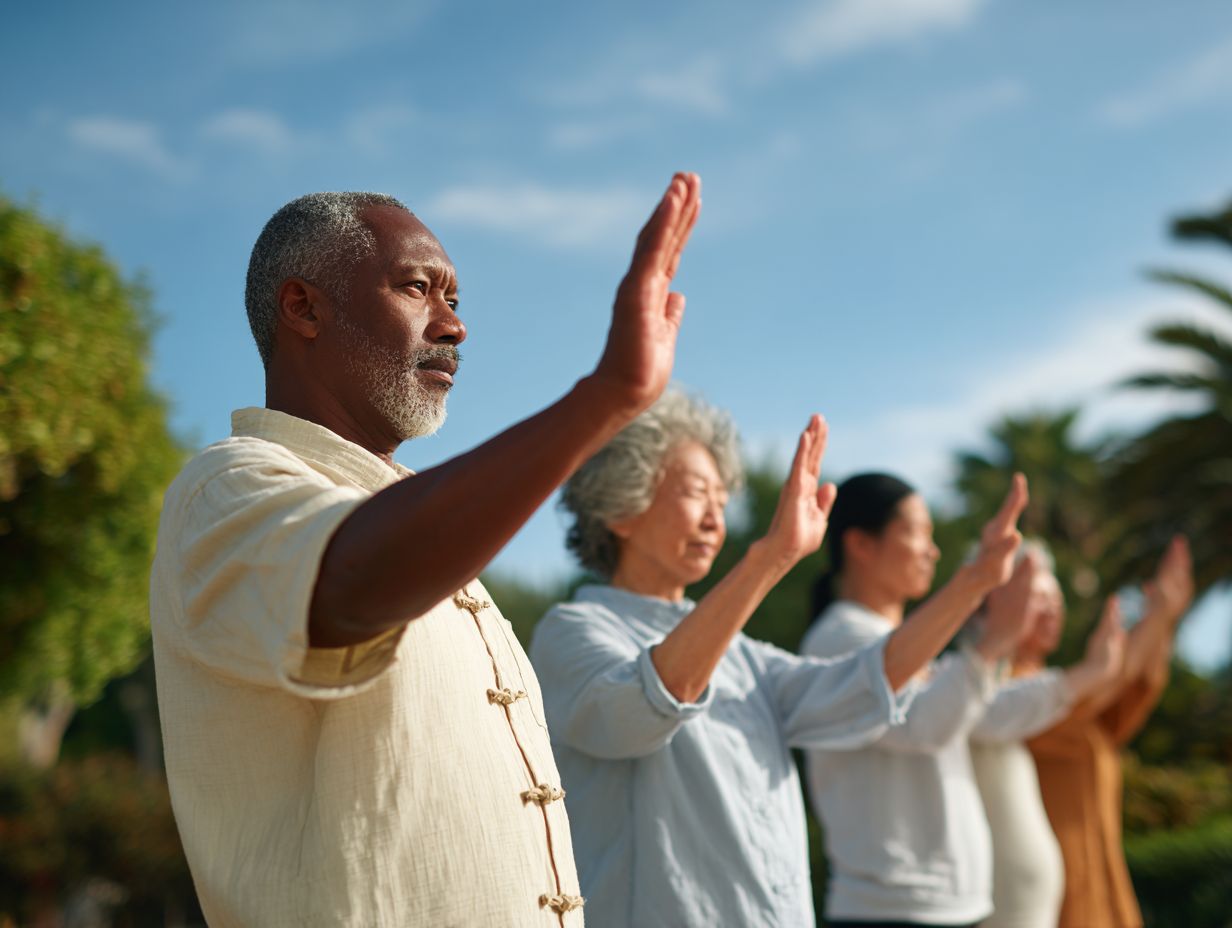
Regular Tai Chi practice can improve balance and strength while alleviating symptoms of arthritis and fibromyalgia.
Studies show that engaging in Tai Chi regularly can reduce the risk of falls by up to 40% in older adults. To reap these benefits, consider joining a local class or using online resources like the Tai Chi for Health Institute. For further understanding of how Tai Chi enhances physical health, you can explore the benefits as detailed by Healthline, which highlights its impact on stress reduction and weight management among older adults.
Try to do at least two to three workouts each week, concentrating on smooth movements to improve balance and flexibility. Incorporating simple routines into your daily life, such as practicing the ‘Parting the Horse’s Mane’ move, can further reinforce these gains and promote overall well-being.
Mental Health Benefits
Practicing Tai Chi can help brain function and increase concentration, especially supporting the part of the brain involved in memory.
Studies highlight that regular Tai Chi practice can lead to significant improvements in memory and cognitive abilities among older adults. A 2018 study revealed that people who practiced Tai Chi improved their thinking abilities by 25% compared to those who did not.
To increase these benefits, think about adding mindfulness techniques. Practices like controlled breathing or checking in with your body during Tai Chi can improve memory.
Aim for 30 minutes of Tai Chi combined with mindfulness exercises at least three times a week for optimal results.
Emotional Well-being
Practicing Tai Chi helps lower anxiety and stress, and builds emotional strength through its calming exercises.
Various studies have shown that practicing Tai Chi regularly can greatly reduce anxiety.
For example, a 2020 study published in the Journal of Therapy found that participants experienced a 30% decrease in anxiety after just eight weeks of sessions. The rhythmic breathing and gentle movements promote mindfulness, enhancing overall mood.
To add Tai Chi to your routine, look for classes or tutorials at least twice a week, using platforms like YouTube or local community centers, to feel better emotionally.
Impact on Chronic Conditions
Tai Chi demonstrates potential therapeutic benefits for chronic conditions, including improvement in symptoms for those with COPD and Parkinson’s disease.
Studies have found that Tai Chi can improve the brain’s ability to change and heal in people with Parkinson’s disease. For instance, a study at the University of Maryland found that participants who practiced Tai Chi exhibited notable improvements in balance and mobility, thus reducing the risk of falls.
Similarly, in COPD patients, Tai Chi’s emphasis on controlled breathing and gentle movement helps improve lung function and overall endurance. Programs like Tai Chi for Health offer clear instructions, making it easy for people interested in physical recovery.
Tai Chi Techniques
Learning the basic techniques of Tai Chi is important for practitioners who want to gain its many health benefits.
Basic Postures
Learning basic positions like ‘Starting Form’ and ‘Single Whip’ sets the foundation for practicing Tai Chi well.
These basic positions improve balance and coordination, which are important for more complex movements.
‘Commencing Form’ involves standing upright with feet shoulder-width apart, arms relaxed at your sides. Slowly raise your arms, palms facing down, before lowering them back down-focus on your breath.
‘Single Whip’ transitions smoothly from other postures, requiring you to shift your weight onto one leg while extending an arm outward.
To learn more, think about signing up for a Tai Chi class or watching videos that show each position. This can help strengthen your practice.
Breathing Techniques
Using correct breathing techniques in Tai Chi aids in relaxation and posture, making them an essential part of the practice.
One effective method is abdominal breathing, where you focus on filling your belly, not just your chest. Begin by inhaling deeply through your nose, allowing your abdomen to expand, and then exhaling slowly through your mouth.
Practice this for five minutes daily, ideally before your Tai Chi session, to increase your awareness of breath and body alignment. Try coupling this technique with your movements; inhale as you lift your arms and exhale while lowering them, creating a fluid connection between breath and motion.
Movement Sequences
Practicing the Yang 24 Form helps you follow a clear path in getting better at Tai Chi.
To get started with the Yang 24 Form, break it down into manageable sections. Start by learning the first six steps:
- ‘Commencing Form’
- ‘Parting the Wild Horse’s Mane’
- ‘White Crane Spreads Its Wings’
Practicing these daily will increase your comfort and fluency. Visual learners can benefit from video resources, such as YouTube tutorials, that demonstrate each movement clearly.
Think about joining a local Tai Chi class to get feedback and improve your skills by practicing with others. This two-pronged approach of solo practice and group learning accelerates your progress.
Styles of Tai Chi
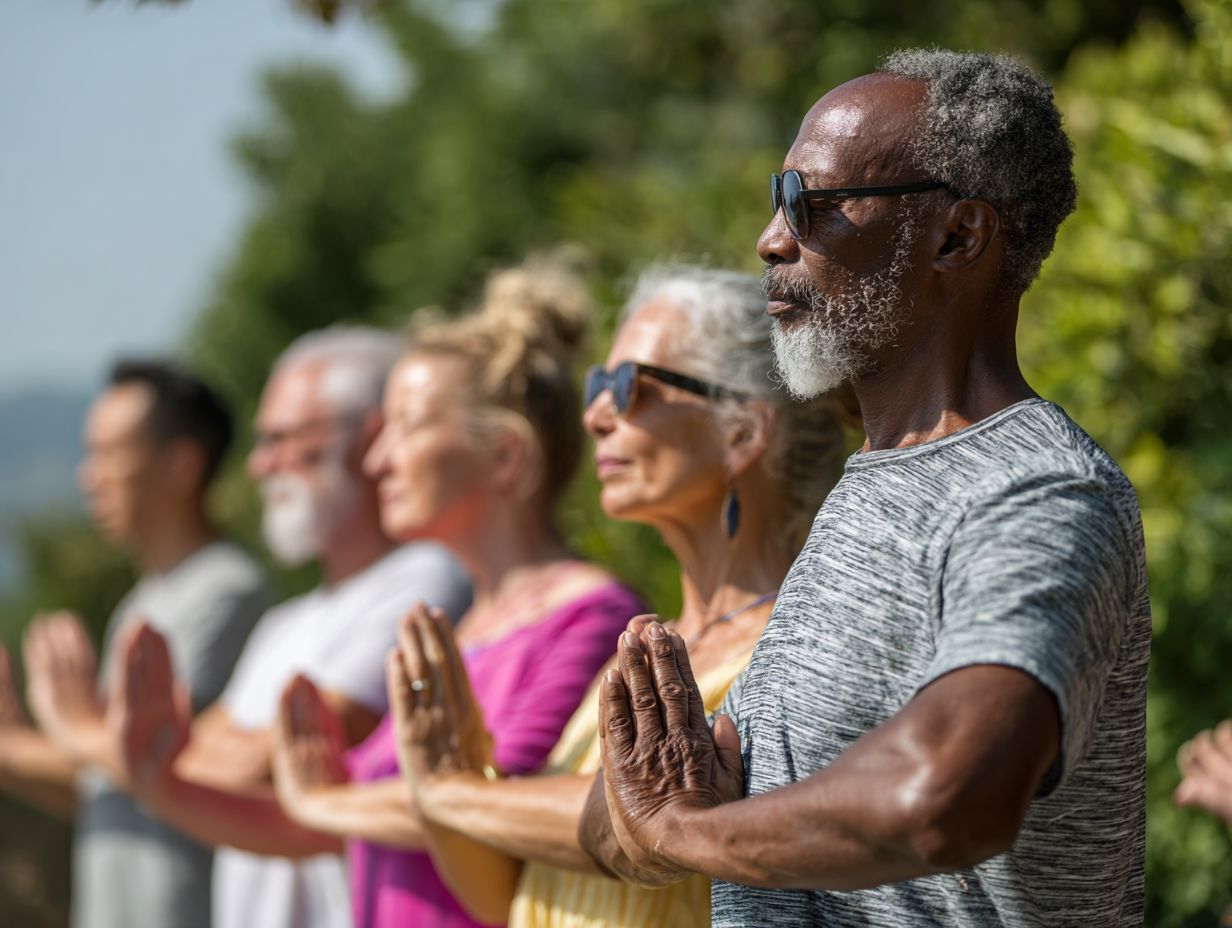
Tai Chi has different styles such as Yang, Wu, Chen, and Sun. Each style has its own features and advantages.
-
Yang style, recognized for its slow and gentle movements, is perfect for newcomers and people looking to relax and reduce stress.
-
Wu style offers smaller stances and is suitable for individuals with limited mobility, focusing on balance and alignment.
-
Chen style features energetic movements and challenging exercises, ideal for individuals with high fitness levels.
-
Sun style combines elements of both, characterized by light footwork and flowing transitions, appealing to practitioners across a range of abilities.
For an in-depth understanding of these practices, consider our deep dive into Tai Chi techniques and wellness outcomes. Choose a style based on your physical condition, goals, and personal preference.
Learning Methods
Aspiring Tai Chi practitioners can choose from various learning methods, including classes, online tutorials, and community center workshops.
For effective learning, consider starting with well-known YouTube channels like “Tai Chi Health” and “Dr. Paul Lam’s Tai Chi Productions,” which offer free instructional videos.
If you prefer personal guidance, search for local instructors through platforms like Meetup or local community centers, often offering classes at affordable rates, sometimes free for the first session.
Apps such as ‘Tai Chi for Beginners’ provide structured routines and demonstrations, allowing flexibility in practice while enhancing your skills at your own pace.
Wellness Tips for Practicing Tai Chi
Setting up a good space for Tai Chi practice improves the workout and makes it more beneficial.
Creating a Practice Space
A Tai Chi practice area should be calm, roomy, and without interruptions to encourage focus.
To create an ideal practice environment, aim for a room measuring at least 10×10 feet. Use gentle lighting, ideally from lamps that mimic sunlight, to increase calmness.
Consider adding elements like a small water fountain or indoor plants, as they contribute to a calming atmosphere.
Essential equipment includes:
- A yoga mat for comfort
- A wall with mirrors to improve your movements
Play soothing background music or nature sounds to further deepen your focus during practice.
Finding an Instructor
Having an experienced Tai Chi teacher helps students learn more effectively and practice techniques safely.
To locate a reputable instructor, start by checking their credentials, such as certifications from recognized Tai Chi organizations.
Next, attend a trial class to assess their teaching style and communication skills, ensuring it aligns with your learning preferences.
Ask healthcare providers for recommendations, as they usually know local instructors who focus on safety and proper technique.
Feedback on how good or dependable instructors are can often be found in online reviews and community forums.
Integrating Tai Chi into Daily Life
Doing Tai Chi daily can help make your body healthier and improve your mental well-being as time goes on.
Consider starting each day with a 10-minute Tai Chi session in your living room or backyard. This gentle practice sets a calming tone for the day.
For those with packed schedules, use lunchtime breaks for a quick 5-minute Tai Chi session, concentrating on deep breathing and easy movements.
Check out community classes that give expert guidance and help you feel part of a group.
Practicing Tai Chi regularly, even for brief periods, helps maintain its benefits and supports a healthier, more balanced way of living.
Common Mistakes to Avoid
Staying away from typical errors in Tai Chi can lead to better learning and help avoid getting hurt.
Some common pitfalls include:
- Rushing through movements
- Neglecting proper breathing
- Failing to maintain balance
To improve, practice moving slowly and deliberately, focusing on each posture without haste. Use deep breathing methods, like breathing from your belly, to improve your movement and help you relax.
If you’re having trouble staying steady, think about using a wall for support or a chair to help while learning the poses. Regularly filming your practice can give useful feedback.
These changes make your practice better and keep you physically safe and mentally clear.
Research and Evidence
Many scientific studies confirm the health benefits of Tai Chi, offering strong proof for its practice. This form of exercise is deeply rooted in Traditional Chinese Medicine, and its therapeutic benefits are comparable to other practices like acupuncture. For instance, Traditional Chinese Medicine highlights various holistic approaches that promote overall well-being.
Scientific Studies on Tai Chi
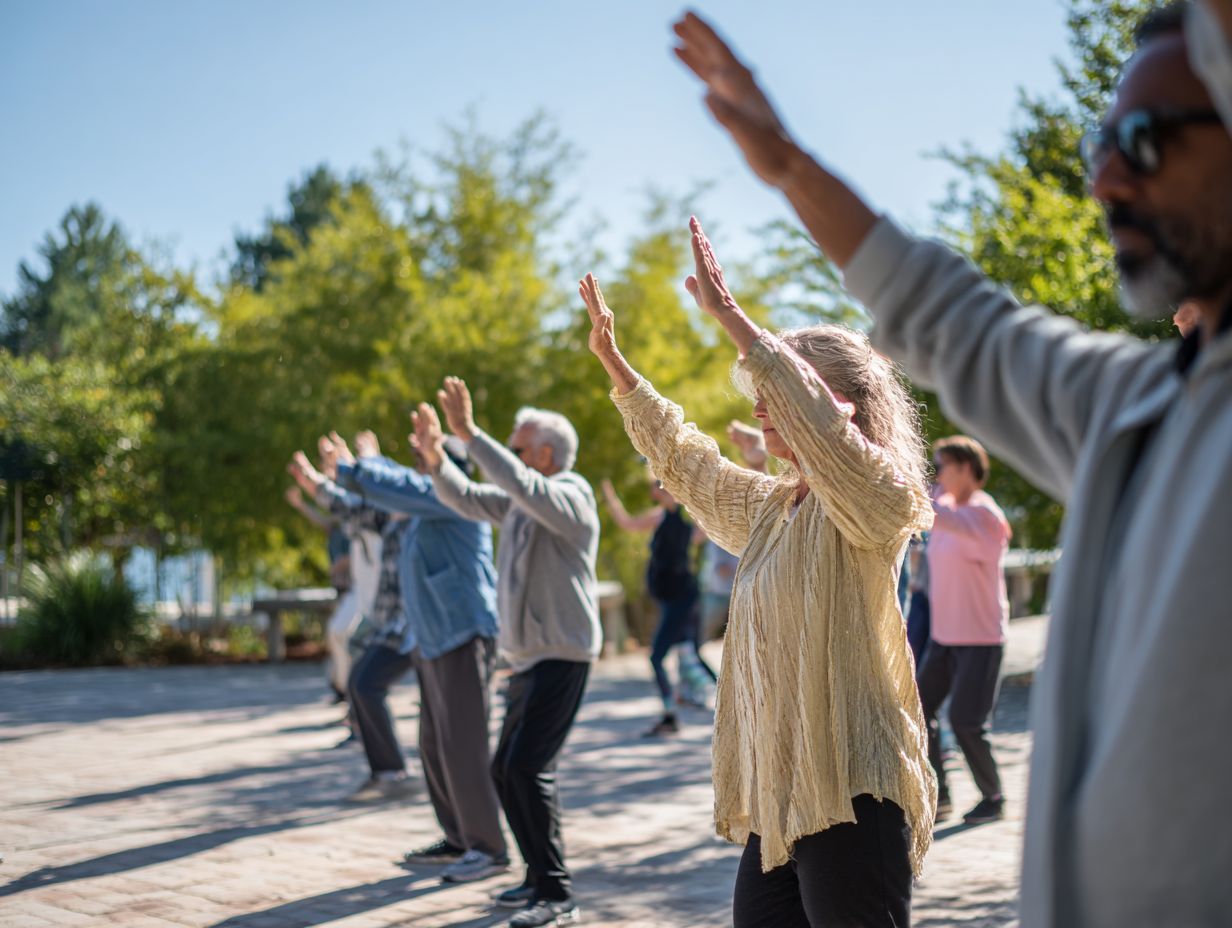
A significant body of research, including studies by Harvard Medical School, highlights Tai Chi’s efficacy in improving balance and reducing stress.
One study involved over 300 older adults practicing Tai Chi for six months, showing a 30% reduction in fall risk. Meanwhile, a randomized control trial found that Tai Chi participants reported significant decreases in anxiety and depression levels.
Practitioners can benefit by integrating Tai Chi sessions into their routines, utilizing resources like video tutorials or local classes.
Apps like Tai Chi Easy or YouTube channels focused on Tai Chi offer guided lessons, helping you begin and keep practicing regularly.
Testimonials and Case Studies
Real-life stories and examples show how Tai Chi can greatly improve people’s health experiences.
For example, Mary, a 65-year-old with arthritis, practiced Tai Chi twice a week for six months, which led to a significant decrease in joint pain and better movement.
Similarly, John, a 72-year-old recovering from a stroke, included daily sessions in his rehabilitation program and found that his balance and coordination improved over time.
Sarah, a busy professional, alleviated her chronic stress by engaging in online Tai Chi classes thrice weekly, which also led to better sleep and increased focus at work.
Each example shows how regular practice can greatly improve well-being.
Final Thoughts on Tai Chi
Practicing Tai Chi can help achieve a balanced, healthier way of life, improving both physical and mental health.
This traditional technique uses smooth motions and focused breathing, and is appropriate for all people.
To begin, think about enrolling in a local class or looking into online tutorials, which frequently provide detailed instructions.
Practicing for just 20 minutes a day can increase flexibility, lower stress, and help with balance.
Using apps like ‘Tai Chi for Beginners’ can help you improve by offering notifications and how-to videos.
Adding Tai Chi to your routine can greatly improve your life through slow, thoughtful movements.
Encouragement to Start Practicing
Starting to learn Tai Chi can be easy. You can join a nearby class or use online materials made for beginners.
To find a class, visit websites like Tai Chi Finder or Meetup, where you can locate local instructors and classes. Community centers frequently organize introductory classes, allowing easy participation.
Consider purchasing a beginner’s Tai Chi DVD, such as ‘Tai Chi for Beginners’ by Dr. Paul Lam, which provides step-by-step guidance.
Online platforms like YouTube also feature channels dedicated to Tai Chi, offering free instructional videos to help you practice at home. Begin with just a few minutes each day, gradually increasing your practice time for the best results.
Frequently Asked Questions
What is Tai Chi and what are its health benefits?
Tai Chi is a gentle form of exercise that originated from ancient Chinese martial arts. It involves slow, graceful movements and deep breathing that promote relaxation, balance, and flexibility. Practicing Tai Chi regularly can help with standing upright, lower stress and anxiety, build muscle strength, improve your ability to move smoothly, and improve heart health.
What techniques are used in Tai Chi and how do they promote wellness?
Tai Chi techniques mainly involve a series of flowing and circular movements combined with controlled breathing and mental focus. These methods improve body awareness and focus, which can lead to better overall health. They also promote the flow of internal energy, or “qi”, throughout the body, which is believed to have a positive effect on various health conditions.
Can Tai Chi be beneficial for individuals of all ages and fitness levels?
Yes, Tai Chi is a low-impact exercise that can be practiced by people of all ages and fitness levels. The slow and gentle movements make it suitable for those with joint problems or chronic illnesses. In fact, Tai Chi has been found to be particularly beneficial for older adults, helping them to improve balance, prevent falls, and reduce pain associated with conditions such as arthritis.
How often should one practice Tai Chi to see its health benefits?
The frequency of practicing Tai Chi can vary depending on individual goals and schedules. To notice improvements in health, practicing at least 2-3 times a week is suggested. This will enable the body to slowly adjust and get better over time. For those looking to maintain wellness and reduce stress, practicing once a week may be sufficient.
Are there any precautions one should take when practicing Tai Chi?
As with any form of exercise, it is important to listen to your body and not push yourself beyond your limits. If you have any health problems, talk to a doctor before starting Tai Chi. It’s important to find a capable teacher and use correct form and technique to prevent possible injuries.
Can Tai Chi be combined with other forms of exercise and wellness practices?
Yes, Tai Chi can be easily combined with other forms of exercise and wellness practices. The slow and gentle movements make it a great complement to activities such as yoga, Pilates, or even weightlifting. Adding Tai Chi to your daily routine, along with meditation and mindfulness, can improve your overall wellness and mental clarity.

Sheetal Sharda has a background in CS. She got an interest in Holistic living back in 2018, and has since started exploring more into Naturapathy, Holistic Living, Yoga, and more. She got inspired to start SereneClinics to help people find reliable centers across the world.
